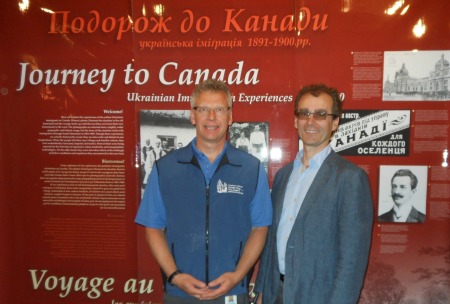
Arnold Grandt and Andriy Nahachewsky at the opening of the Journey to Canada exhibit
The Ukrainian Cultural Heritage Village officially opened for the season on Monday, May 20 with the exhibit Journey to Canada and celebration of Ukrainian dance.
The exhibit Journey to Canada: Ukrainian Immigration Experiences 1891-1900, produced by the Huculak Chair in the Kule Folklore Centre at the University of Alberta, has been complemented by pioneers' items from the UCHV collection. The exhibit will be on display from May 18 to September 2, 2013.
This exhibit is part of a larger project, started some 15 years ago. The project has had many researchers and authors and participants come and go over that time. The overall intent of the project is to explore and share new information about the pioneer experience of Ukrainians in western Canada. We want to publish a series of books written for a general audience, illustrated with lots of historical photos and interesting contemporary connections. When we started researching and writing the first book, we realized that we'd have to break it up onto smaller topics. The first topic, then, was the actual journey, physically travelling from villages and towns in Ukraine, then the Austro-Hungarian Empire, to the port in Europe, across the ocean, immigrating into Canada, then travelling again across this enormous country to the prairies, and still farther until they reached the actual land that they would settle on. Just the travel was an immense, amazing, scary adventure. Most of the people were peasants or small town residents, and most of them had rarely or never been to their own major cities, never mind travelling around the world. That is what Journey to Canada documents. Our goal remains to produce a book, which allows for much more specific information, to accompany the exhibit or to stand alone as a document, for sale in places like the Ukrainian Cultural Heritage Village, as well as distributed to Alberta school libraries, other museums, etc.
We have plans for a second book and exhibit, as well as third ones already. We would like to work together with the Ukrainian Cultural Heritage Village and the Friends Society to make a trio of exhibits. The second one would deal specifically with how to set up a homestead once you arrived on your land. Clearly, there was a lot involved there, the house, animals, garden, clearing the land, adapting to the Canadian winter, engaging with the wilderness, and other important topics. The third one would deal with life beyond the homestead, cooperating with neighbours, building a community, travelling to the store and the post office, building a church, developing roads, perhaps travelling away for work to earn some cash.
We worked hard to bring new information to the project, not just repeat the typical stories of the journey, but to dig deeper into archives of historical photos, to focus specifically on one time period and notice the changes that occurred quite quickly in that time: immigrants in 1899 already had quite a different experience than those of 1892, for example. We concentrated on specific events and specific locations, so this exhibit, for example, deals specifically with people who travelled to Edmonton. The photos of the exhibit come from our own Bohdan Medwidsky Ukrainian Folklore Archives at the UofA, Radomir Bilash's collection, the Provincial Museum of Alberta, the Glenbow Museum in Calgary, the United Church of Canada Archives, the Library of Congress, the Norway Heritage Collection, Edmonton City Archives, the National Library and Archives of Canada, the Pat Tomkow collection, the Alberta-Ukraine Genealogical Project, and other places.
This exhibit is the fourth one created by the Kule Folklore Centre, and perhaps our most successful one to date. It was premiered in Montreal in 2011, then was seen by many people at the Toronto Bloor West Village Festival, in Hamilton, in Surrey and Mission, BC. It showed briefly as part of an exhibition in Edmonton hosted by the Ukrainian Museum of Canada at St. John's Cathedral, but this will be the first time it is displayed for an extended period of time. We are very pleased to present it here at the Ukrainian Cultural Heritage Village, in a setting that deals so powerfully and extensively with the early experiences of Ukrainians in Canada.